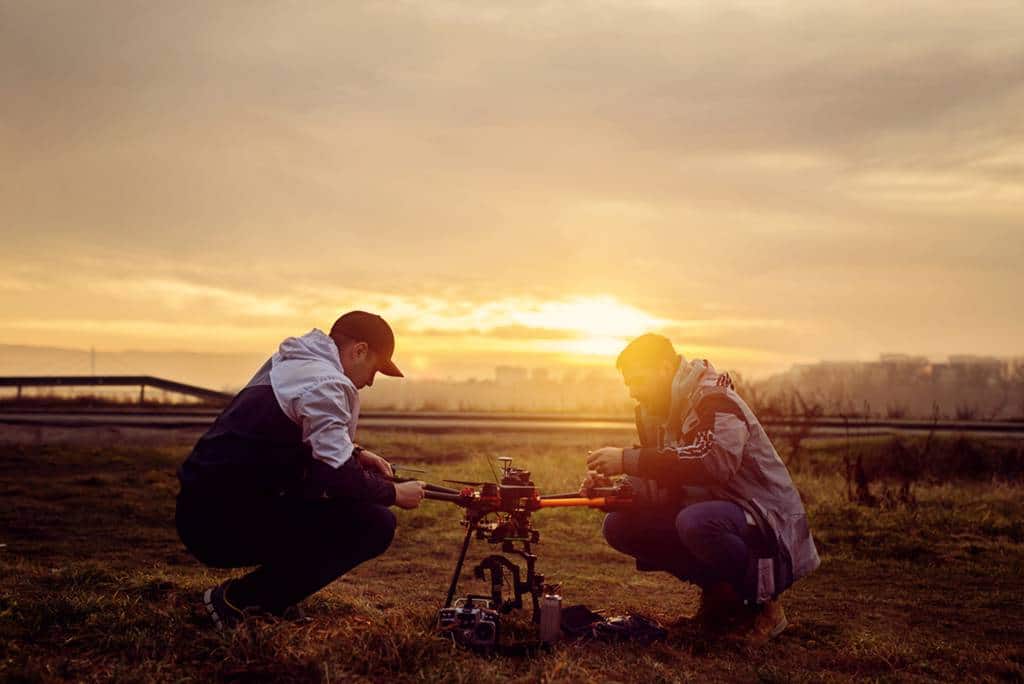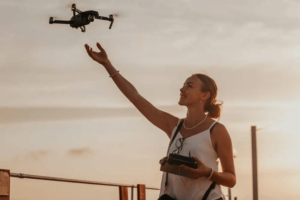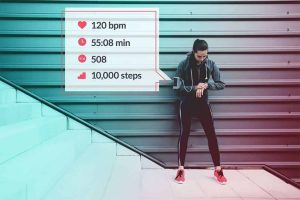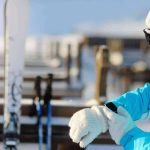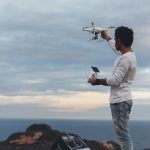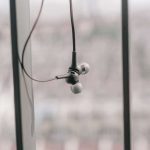The most difficult part of being a commercial drone pilot is finding paying jobs. The second most difficult part is getting the right weather to fly. I have had more days of flying rescheduled due to weather problems than days that went as planned. I spend many mornings scanning weather websites, viewing my favorite iPhone forecast apps, and watching the flag blowing at the end of my driveway. To make money, you want to fly a project well and, preferably fly it only once. You also want to have smooth air and light that enhances the aerial view.
The weather is your master. The only thing you can do is learn to plan, interpret forecasts, be able to move fast during a clear sky opportunity, and most importantly, have patience.
Too many times I got rushed, did not heed the wind warnings, and went ahead with my planned flight. Usually, this led me to bring the drone down immediately due to gusty winds buffeting my Phantom, which overburdened the gimbal. The result would have been a shaky video. The projects where I waited for favorable weather conditions and preferred lighting worked out better, and I did not waste time or put my UAV in peril.
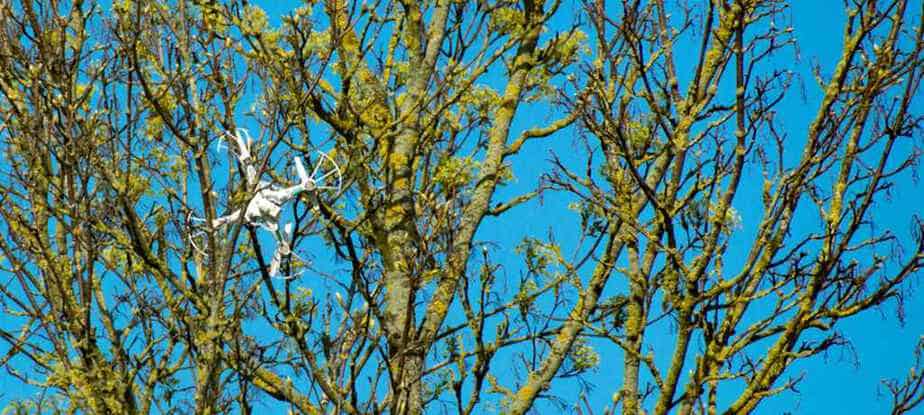
Weather Issues When the Client Has Time Expectations
You will have times when a client sees your past aerials becomes very excited to get his or her ranch photographed, and wants it done immediately. This is where you have pulled on the reins and set some time expectations. Explain to the client the difficulties with weather, which include wind, lighting, possibilities of rain, and even low clouds. Let the client know that it could be several days or maybe even a couple of weeks before you are able to fly under favorable conditions. It can get even more complicated when only specific time windows during the day are available.
You could have had a smooth air morning with good light at 9:00 a.m., but the client wants a sunset. That can be troublesome in the summertime when afternoon thunderstorms and warm thermals are probably in Texas; always keep seasons and weather in mind wherever you are. Other conflicts involving weather could occur when the client wants to be present for the aerial photography flight because he or she wants to watch the flight and help direct what is filmed.
The windows of availability, coupled with good flying weather, can be very difficult to synchronize. Work with the client and explain how you need the flexibility to adapt to ever-changing weather conditions.
Some areas of the US are more weather-friendly than others. Flights planned in sunny, southern, inland California can be much more predictable than those north of foggy San Francisco. The same goes for times of the year; for example, here in Texas when we get a high-pressure cell parked over our state for weeks, clearing our skies and calming our winds, it is time to fly!
Smartphone or Tablet Weather Apps
Mobile weather applications are critical for the commercial drone pilot. We have to have the most up-to-date forecasts by multiple sources, so we can take the average of their educated guesses and hope to be right. As the weather can change on a dime, our need to stay informed on atmospheric developments during UAV flight windows is very important.
Fortunately, there are numerous smartphone and tablet weather apps available to meet those needs. This is especially true for iPhones and iPads, with apps from the Apple App Store.
Some are free, and some are inexpensive. My favorite weather app is “The Weather Channel Max,” which has the icon of TWC Max. For planning, I use the 10 Day forecast to target a good sunny day with minimal winds. On flight day, the first thing I use is the Hourly tab to pick the time to fly or see if my fixed time window is clear.
The Weather Channel Max App For critical storm-dodging information, I use the iPhone app RadarScope. I used that jewel during my tornado chasing days back in 2010. This $10-a-year subscription level app did an awesome job helping me find funnels in Oklahoma, and now I use it to help me see the bad weather coming. It will display storm tracks and lightning strikes headed your way so you can avoid them. Another handy weather app to have in your arsenal is RainAware.
This GPS-based app will tell you to the minute when rain from a storm will arrive at your location. I have cut it close on a few flights trying to get that last sortie in just to make sure I got the video I needed. Once, this app displayed that I had 30 minutes until a 70 percent chance of rain hit. I used the window, got another fresh battery in my Phantom, got the bird up, got the shot, landed safely, packed up the case, and it started raining within 3 minutes of RainAware’s calculation.
Avoid Winds and Rain
Not flying in the rain seems obvious, but when your UAV is more than half a mile away over a pasture, and a fast-moving storm develops out of nowhere behind you, avoiding rain can become an emergency. Knowing the predicted chance of rain for that area during that time window is crucial for planning and must govern your plans. For planning purposes, don’t plan on flying if there is more than a 50 percent chance of rain. Watch the forecast carefully, with optimism, if it is 20 to 40 percent, and plan for a strong probability you are flying if the forecasted rain is 10 percent or less.

Utilize all three of the previously mentioned apps to closely monitor the conditions when your bird is in flight. Remember, just a few raindrops inside an electric engine can take down your UAV, and if the internal circuits get wet, the whole bird can fry.
RainAware App Though wind will not likely destroy your drone as fast as rain can, it can spell trouble for flight stability, and high winds can endanger it. My rule of thumb is to avoid average winds in the teens.
I’ll fly in 10–12 mph winds, but will opt out in the 13–15 mph range. Any wind higher than 15 mph is the line for grounding for my UAV fleet. Though Phantoms can fly in winds that are 20–25 mph, you are risking the UAV and pushing safety thresholds. High-teen winds push the engines, strain the props, drain the batteries faster, and make for poor aerial video. The 3-axis gimbal can handle winds 10 mph and less just fine. However, less wind is always best. When my driveway flag is hanging down perfectly still, I want to have my bird in the air earning.
Seasonal Climate Aerial Factors
It is not just the day-to-day and hour-to-hour weather limitations that should be monitored, but the longer term issues regarding seasons need to be considered. In Texas, there are two times of the year when the ground looks brown and dead, which is not especially photogenic.
During what seems to be our seven weeks of winter from mid-January until the end of February, the trees have no leaves and the grass is weedy brown. Six months later in the peak of our five-month summer with no rain, the trees may have left but the ground is again brown and cracked. In the springtime, most everywhere in the US will be your best business flying season due to moderate temperatures and blooming foliage. The March-April window is bluebonnet season here in central Texas, which makes UAV pilots clear their calendars for clients requesting springtime flyovers.
The beauty of leaves changing their colors in the fall can be another aerial photography opportunity, especially in the northeast before the snow starts falling.
To keep your bird flying and to earn consistently through the calendar year, you will need to diversify your client base. Strive to serve multiple industries with busy times that have little overlap. In other words, make sure you have enough aerial photography work from various clients to avoid the feast and famine pitfalls into which many small businesses fall.

